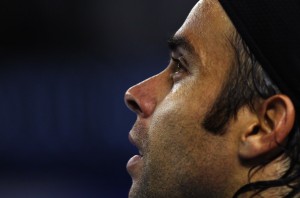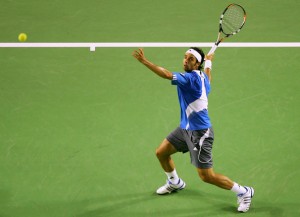Fernando Gonzalez – not quite Chile’s most successful player, but arguably its most admired – today announced his retirement from professional tennis, effective following the Miami Masters in April. His last few seasons have been heavily abbreviated by injuries,  and he conceded that he no longer has the energy to compete at the highest level. Age, inevitably, has wearied him. He leaves the sport with 11 career titles, and an overall match record – so far – of 368-199 (.649).
and he conceded that he no longer has the energy to compete at the highest level. Age, inevitably, has wearied him. He leaves the sport with 11 career titles, and an overall match record – so far – of 368-199 (.649).
I first watched Gonzalez play live at the 2002 Australian Open, when as a Qualifier he took out Tommy Robredo in straight sets. My initial impressions have barely been altered upon many subsequent viewings. They are, in no definitive order: that his clothes seem unnaturally clean; that the ball makes a slightly different sound as it strikes his racquet than it does for most other players; that the trajectory of his backhand drives is unlike any other, and from close range feels like the lowest-percentage ground stroke in the sport; that he appears taller than the listed six feet; and that he is likely to erupt at any moment, from the coin-toss onwards. Aside from the first point – seriously, he is like a detergent ad – these seem to be the same impressions just about everyone has.
As with the personal impressions, I won’t pretend my favourite moments from Gonzalez’ career differ markedly from those of everyone else. It would be mere posturing to pretend that his most famous moments were not also his greatest, and would entail peddling the false idea that obscurity holds inherent value, when so often the inverse is true. Mining the Chilean’s record reveals that he won Vina del Mar four times. It’s possible he was majestic on each occasion, and especially the first, but I’d be lying to insist upon it. Alas, I did not witness that triumph, or the other three. However, I do know for a fact that the best match Gonzalez ever played was in the semifinal of the 2007 Australian Open, when he demolished Tommy Haas so completely that the German barely had time to abuse his coach, even if he was afterwards generous in blaming Gonzalez.
This match, which Gonzalez won 6/1 6/3 6/1 in 91 minutes, was the highest point in a high week, as he scaled a draw that was roughly analogous to the north face of the Eiger, although upon attaining the summit he discovered the most merciless Swiss peak of them all. Federer cleaned him up in straight sets, but it’s important to remember that Gonzalez served for the first set. Had he served for it better, things might have been different. He’d already taken out Nadal in straight sets in the quarterfinals, and the way he’d gone about it was profoundly revealing.
The standard word on Gonzalez is that he has one of the biggest forehands in tennis. Gael Monfils may hold the speed record (at something like 190 km/h), but Gonzalez is not far behind, and gets up there consistently. Searching Youtube for ‘Gonzalez forehand’ yields no shortage of results, with this clip being about the most comprehensive:
I’m not a very big fan of highlights clips, since among their panoply of distortions they tend to buttress the lazy assumption that great matches are merely the sum of their best shots. But in this case it’s not important. What’s important is that thunderous, murderous forehand, although even here it’s wise to remind ourselves that even so a mighty a shot should not be unhooked from its role, its purpose. It’s a signature shot, but a signature without context is useless – it’s just an autograph. Watching such a highlights clip, it’s forgivable to ask how Gonzalez ever lost a match, even as we remind ourselves that he never won a tournament that really mattered. The series of savage blows with which he knocks down Federer in Shanghai 2007 – beginning at 2:22 – may have won him the match, but Federer won the event. I suppose what I’m saying is that if you’re inclined to appreciate a ground stroke in isolation purely on its aesthetic merits – and if you are so inclined then this clip should move you to tears – then you could do worse than Gonzalez’ forehand. But we’re doing him a disservice if we suggest a forehand is all he has. Gonzalez always had plenty more going for him than that.
Indeed, all the talk as he tore through the Melbourne draw in January 2007 was of his backhand, and not the streaky, top spun version. The forehand was, naturally, decisive, but it was the Chilean’s willingness to extend points with the sliced backhand, rather than end them with extreme prejudice, that provided the talking point.  Under the presiding gaze of Larry Stefanki, the view gained currency that Gonzalez had finally gotten the balance right, tempering his volatility with patience, committing to defence as though it was actually a part of the sport. Nadal found him impenetrable, and lethal on anything short.
Under the presiding gaze of Larry Stefanki, the view gained currency that Gonzalez had finally gotten the balance right, tempering his volatility with patience, committing to defence as though it was actually a part of the sport. Nadal found him impenetrable, and lethal on anything short.
For whatever reason, it didn’t last. He followed up his run to the Australian Open 2007 final with a season that we might generously term middling, although given his lofty top-eight ranking it was frankly worse than that. He failed to win a match in the North American summer. The measured patience of that Melbourne turned out to be the strangest of anomalies – a lack of flash in the pan – and it would rarely, if ever, be seen again.
Which isn’t to say he never again posted great results, but they were achieved by sprinting along a tightrope, which for flair is hard to top. But it meant that a misstep was disastrous. Everyone remembers his 2009 French Open semifinal against Soderling for the disputed line call in the fourth set, which culminated in Gonzalez clearing the mark with his bum. What is generally forgotten is how favoured the Chilean was for this match; higher ranked, a bone fide clay courter riding a four match winning streak against an opponent appearing in his first major semifinal. Gonzalez led 4/2 in the fifth. But he lost. It was tremendously entertaining, but he lost.
Sometimes, of course, he won, as with the utterly uncompromising 12-10 fifth set victory over Gasquet in Melbourne a few years ago. It was electrifying, and all of us who saw it came away wondering why tennis can’t always be played like this. The fact is, tennis can be played like this, but not for long, because the guys become harder to hit through in the later rounds. Gonzalez’ solution to this has invariably been to hit harder. If ultimately it never proved effective on the most prestigious stages, it was never less than exhilarating. Tennis will lose one of its great personalities in April, but even now I cannot shake the belief that we could have been losing one of our great players.

6 Responses to Remembering Gonzo